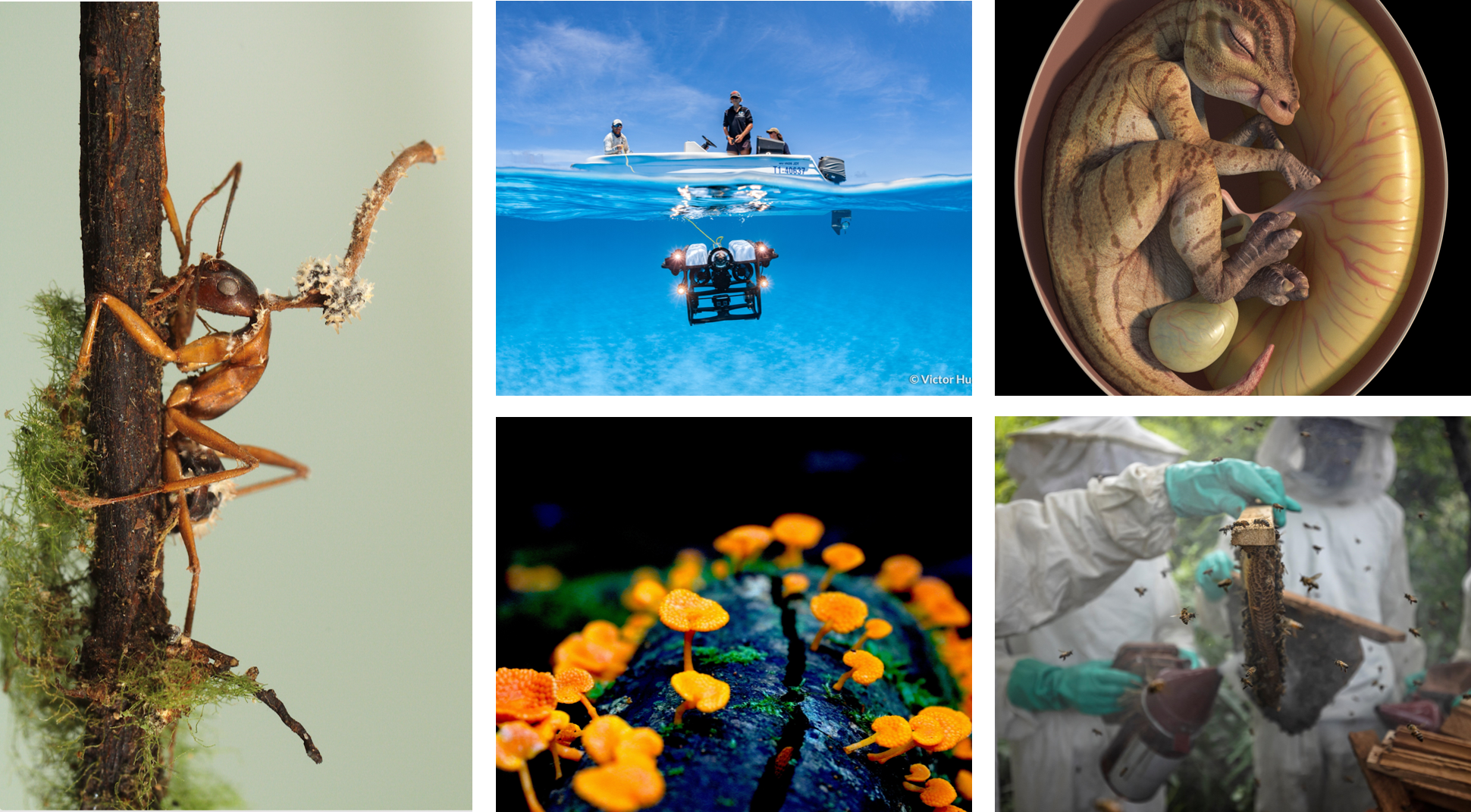2024 BMC Ecology and Evolution and BMC Zoology Image Competition
Published in Ecology & Evolution and Zoology & Veterinary Science


Last year’s BMC Ecology and Evolution image competition attracted substantial attention from researchers and the wider public. Over 160 international media outlets highlighted the winning images, including CNN, Live Science, BBC Science Focus, Popular Science, Newsweek, Gizmodo, El País, MailOnline and National Geographic España.
Don’t miss your chance to highlight your research, win prizes and have your images featured on the BMC Ecology and Evolution and BMC Zoology websites. The winners will also be announced via an editorial published in BMC Ecology and Evolution.
The competition provides a fantastic opportunity to showcase research and the beauty of nature to a broad audience. Anyone affiliated with a research institution working within the field of Ecology, Evolutionary Biology or Zoology is eligible to enter one image into each of the following four categories:
1. Research in action. Images that showcase ecological, evolutionary biology or zoological research or capture experiences of conducting studies and collecting data.
2. Protecting our planet. Photos conveying efforts to support and raise awareness of the United Nations Sustainable Development Goals (SDGs) or the UN Decade on Ecosystem restoration:
- SDG6.6: Protect and restore water-related ecosystems
- SDG14: Conserve and sustainably use the oceans, seas and marine resources for sustainable development
- SDG15: Protect, restore, and promote sustainable use of terrestrial ecosystems, sustainably manage forests, combat desertification, and halt and reverse land degradation and biodiversity loss.
- 2021-2030 United Nations Decade of Ecosystem Restoration
3. Relationships in nature. Photos depicting symbiosis, including parasitism, plant-fungi relationships, plant-pollinator interactions, mimicry, mutualism, commensalism, cleaning symbiosis, and co-evolutionary relationships.
4. Life close up. Photos displaying biology that is not often seen using close-up or macro photography.
Judging and prizes
Judging the competition will be members of the BMC Ecology and Evolution and BMC Zoology senior Editorial Board, along with Jennifer Harman (the Editor of BMC Ecology and Evolution) and Marie-Therese Nödl (the Editor of BMC Zoology). The journals will award the overall winner €800, and the winner for each of the four categories €200. The journal will also award €50 to the runner up for each category.
How to submit
Please email your images to Jennifer Harman, at jennifer.harman@springernature.com with the subject line “Image Competition 2024” and include the following:
- Your name:
- Affiliation:
- Contact details of Research Institute:
- Twitter handle (optional):
- Category:
- Image name:
- Description (Max. 250 words):
- File type:
- Data attribution (if applicable):
- I agree to release this image under a Creative Commons License: Y/N
Please attach your image entry to your email.
Rules:
- Anyone affiliated with a research institution working within the field of Ecology, Evolutionary Biology, Paleoecology or Zoology is eligible to enter.
- Resolution Requirement: Images must have a minimum resolution of 300dpi (1831 x 1831 pixels for a raster image) and a maximum file size of 10MB.
- File Format: Images must be saved in TIFF, JPEG, or RAW file formats.
- Ownership Rights: The image submitted must be your own, and you must possess the necessary rights to use it.
- Exclusion of AI Generated Images: Images generated using artificial intelligence (AI) will not be considered for the competition.
- Creative Commons Licensing: By entering the competition, you agree to release the images under a Creative Commons license (https://creativecommons.org/licenses/by/4.0/) in alignment with our open access policies. This allows for file sharing with proper attribution.
- Judging: Winners will be judged by BMC Ecology and Evolution and BMC Zoology Editors and Senior Editorial Board Members. Unfortunately, we are unable to provide feedback to every applicant.
The deadline for entries is the 21st of June 2024, with the winners being announced on August the 16th.
Follow the Topic
-
BMC Ecology and Evolution

An open access, peer-reviewed journal interested in all aspects of ecological and evolutionary biology.
Related Collections
With Collections, you can get published faster and increase your visibility.
Bioacoustics and soundscape ecology
BMC Ecology and Evolution welcomes submissions to its new Collection on Bioacoustics and soundscape ecology. By studying how animals use sound and how noise impacts them, you can learn a lot about the well-being of an ecosystem and the animals living there. In support of the United Nations Sustainable Development Goals (SDGs) 13: Climate action, 14: Life below water and 15: Life on land, the Collection will consider research on:
The use of sound for communication
The evolution of acoustic signals
The use of bioacoustics for taxonomy and systematics
The use of sound for biodiversity monitoring
The impacts of noise on animal development, behavior, sound production and reception
The effect of anthropogenic noise on the physiology, behavior and ecology of animals
Innovative technologies and methods to collect and analyze acoustic data to study animals and the health of ecosystems
Reviews and commentary articles are welcome following consultation with the Editor
(Jennifer.harman@springernature.com).
Publishing Model: Open Access
Deadline: Mar 27, 2026
Impact of climate change on ecology and evolution
BMC Ecology and Evolution is calling for submissions to our Collection on Impact of climate change on ecology and evolution. This Collection seeks to explore how climate change alters ecological dynamics and evolutionary processes, including shifts in phenology, local adaptations, and responses to invasive species. By understanding these shifts, we can gain insights into the resilience of ecosystems and the adaptive capacity of species in a rapidly changing world.
The significance of this research is underscored by the ongoing challenges posed by climate change, which threatens biodiversity and disrupts ecosystems. Recent advances in ecological modeling and genetic analyses have provided new tools to assess the impacts of environmental change on species and communities. These insights are crucial for developing conservation strategies and management practices aimed at mitigating the effects of climate change and preserving biodiversity for future generations.
Continued research in this area promises to enhance our understanding of the interplay between climate change and ecological dynamics. As new data emerges, we may uncover novel adaptive strategies employed by species in response to environmental shifts, revealing patterns of gene flow, population dispersal, and phenotypic plasticity. This knowledge can inform conservation strategies that are increasingly vital in an era of unprecedented environmental change.
•Climate change and biodiversity loss
•Phenotypic plasticity in response to environmental change
•Effects of invasive species on ecosystems
•Local adaptation and genetic structure in changing environments
This Collection supports and amplifies research related to SDG 13: Climate Action and SDG 15: Life on Land.
Publishing Model: Open Access
Deadline: Mar 03, 2026





Please sign in or register for FREE
If you are a registered user on Research Communities by Springer Nature, please sign in
Hi Jennifer,
I would like to invite you to discover this text, which focuses on a fascinating theme:
Damus, O. Regenerative and restorative pedagogy: The foundation of a new contract for cognitive justice. Prospects (2024). https://doi.org/10.1007/s11125-024-09683-y
https://link.springer.com/article/10.1007/s11125-024-09683-y.
Best regards.
Obrillant Damus.